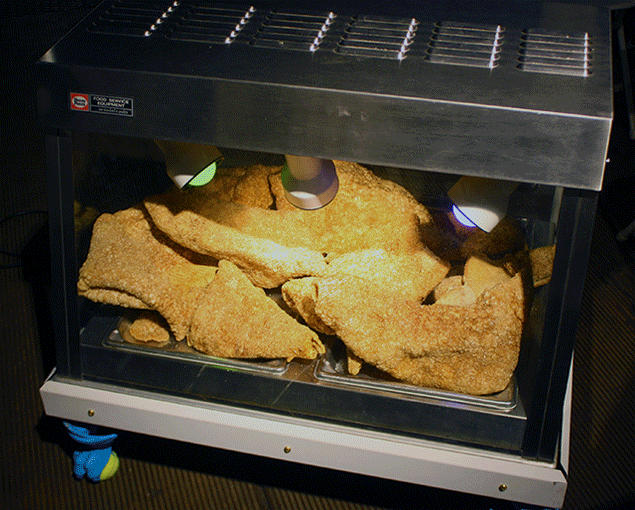
Jorge Galvan, “Chicharron”
Last weekend, Open Space hosted their seventh annual Publications and Multiples Fair, a smorgasbord of DIY press, affordable artwork, and booths from artist-run spaces around the country. I posted a slideshow of the fair, but also went to about a dozen galleries neighboring the Baltimore Design School (site of PMF VII) and Open Space’s brick-and-mortar location. Below are some briefly-annotated highlights.
Across the street from PMF, Area 405 hosted TRACES, Ni de Aquí, Ni de Allá, a survey of Latino artists from curator Ashley Delara Dehoyos. I’m equally grossed-out and transfixed by Jorge Galvan’s disco vitrine of stale chicharrones (fried pig skin, in the GIF above). I think the “legs” are blue turkey feet clutching tennis balls? It’s a nice detail I didn’t notice until looking through my photos. But the show-stopper here is Ryan M Flores’s ceramic installation, a candy-hued gothic arch sprawling onto the floor from the wall. It’s evocative of an archaeology site where one is attempting to reconstruct architectural ruins. (On view until April 22nd)
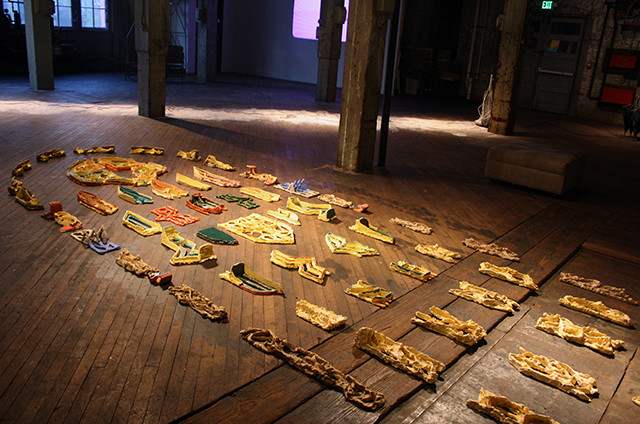
Ryan Michael Flores, Installation view.
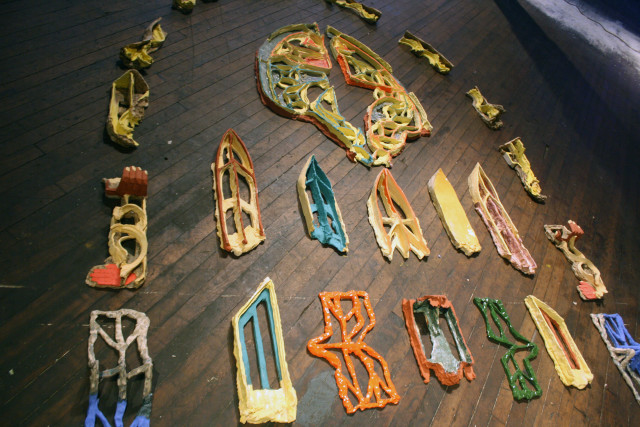
Ryan Michael Flores, Detail

Wickerham & Lomax
Terrault Contemporary opened Uncool from Wickerham & Lomax, a series of digital prints stretched like paintings or bundled into mesh “purses”. They represent a departure from the duo’s installation-based practice, veering far closer to the realm of traditional “art object” while still managing to be incredibly weird. Some panels remind me of esoteric religious icons, jam-packed with tiny details alluding to a complex narrative. Others almost read like advertisements, pitching products like hyper-customized handbags printed to look like gross balls (or maybe butt-cheeks) pressed against clear plastic. At an artist talk before the reception, both artists claimed they never listened to music growing up, or in the studio. Looking at these, I imagined this is what pop culture and subculture appropriating each other would look like if music didn’t exist. I’m always impressed by their ability to produce an alternate pop reality, or imaginary underground. In either case, their visual language is so absurdly specific it feels almost vague—as if the inhabitants of this world are intensely, deliberately focused on aloofness. (On view until April 30th)

Wickerham & Lomax. These bag prints remind me this one Michael Kors storefront that’s always over-lit and staged in an extremely gaudy fashion. These seem to be answering an overly-sanitized consumer culture proposal for endless alternatives.

Wickerham & Lomax detail.
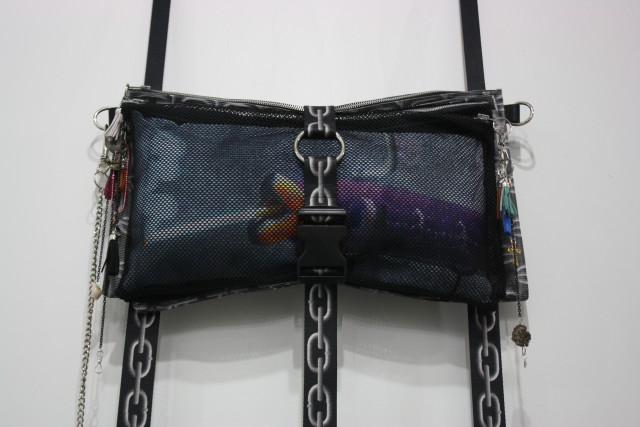
A Wickerham & Lomax “purse” featuring a smoking fish and dripping with keychain charms.
Around the corner, La Bodega Gallery‘s survey of female-identified artists We Make it All to Have it All was a bit over-hung, the way many such group shows often are. I wished there were some curatorial editing beyond the gender of the artists here, as some of the most interesting works disappeared in the crowd. I’d love to see a smaller show culled from this group of artists—there were particularly strong pieces that played with patterning and textile-as-painting. Two highlights included Suzy Gonzalez’s bizarre painting of Llama Lady (my new favorite superhero) and April Camlin’s embroidered digital prints (she showed similar work in a booth at PMF).
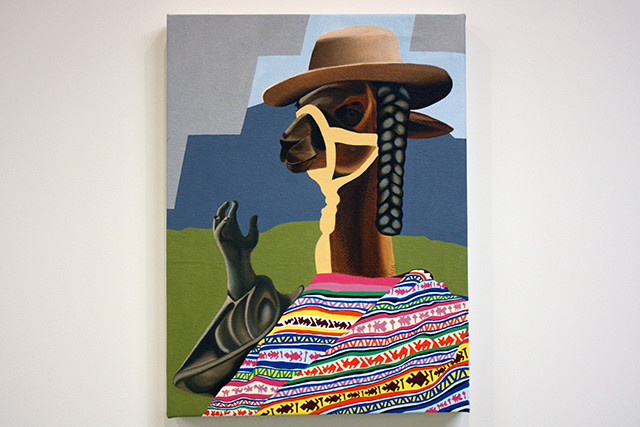
Suzy Gonzalez, “Mujer Llama desde Cusco”

April Camlin, “Passenger,” “Learning to Lighten Up” (the one with colors), and “Of Inverse,” embroidery on digitally-printed canvas.
At Ballroom Gallery‘s The Edge, I saw just about everyone get up close to these enormous paintings by Taha Heydari to see if they were digital prints. The artist convincingly recreates the look of data-moshing or corrupted video with a combination of taped-off blocks of color and a stamp-like repetition of painterly marks. They’re beautiful and a little off-putting at the same time. Titles such as “The Executioner” and “Minister of Public Enlightenment” suggest dystopian quality, as if we’re seeing scrambled propaganda or perhaps a pirated version of an encrypted file from some authoritarian regime.
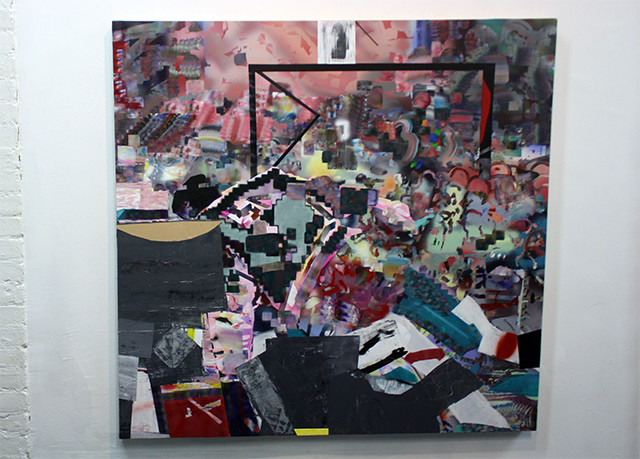
Taha Heydari, “Execution,” acrylic on canvas.
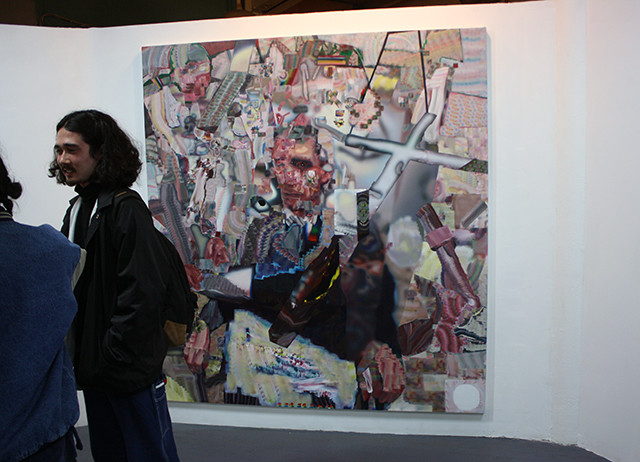
Taha Heydari, “Minister of Public Enlightenment,” acrylic on canvas.
Lighthole is a monthly new media/performance series and journal (they also had a table at PMF VII) that is loosely organized around a different theme for each edition. I always attend this with an expectation of how that theme might manifest, and I’m almost always surprised. This month was “Pits,” which inspired C. Tara and David Gladden to collaborate on this sci-fi-tanning-bed-looking tableau, which looked oddly inviting.
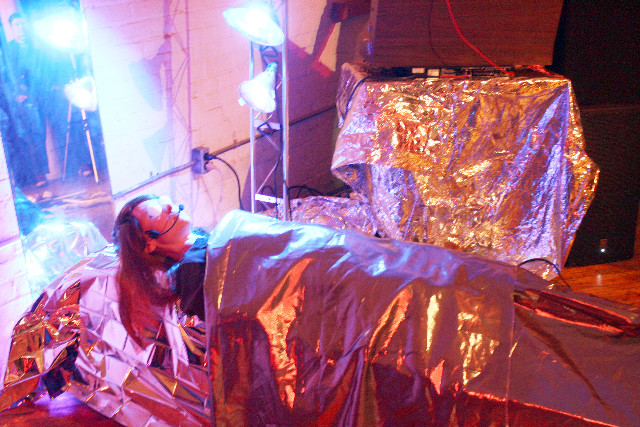
C. Tara and David Gladden, “The Sleep of Reason Produces Monsters”
And this performance from Alexander D’agostino, which involved the artist putting sticks in his butt while dancing on a chair. I can’t stress enough how, in person, this was such a captivating combination of being absurd and totally suspenseful. D’agostino would perch in precarious positions until he fell, put more twigs in his butt, and then get back up and cycle through motions such as pirouettes and humping the chair. Eventually, it broke. It was almost like he was trying to fuck the chair back into splinters of wood to join the mound of sticks.
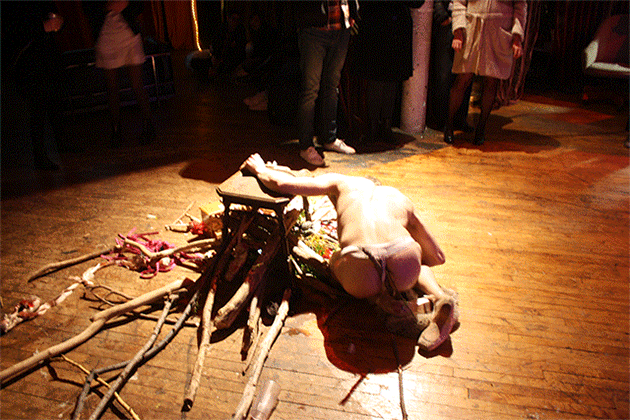
Alexander D’agostino

Noa Glazer at bb’s “A Temporary Curse”
Saturday night, bb‘s understated group show A Temporary Curse was a welcome respite in a weekend characterized by over-stimulation. All the work here is quiet and smart. This oversized witch hat and sleeping bag are gorgeous and so well-crafted they look like store-bought objects. I wouldn’t expect anyone to purchase this from a camping store, though—it’s constructed from water-soluble material. I love the irony of an object designed to retain body heat that would be destroyed by sweat. There’s so much loving labor that went in to creating something doomed to destroy itself if it interacted with the human body. (On view until May 21)
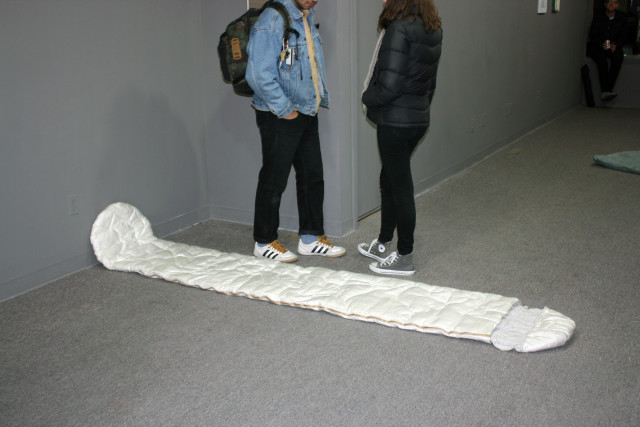
Noa Glazer

Stephanie Hier, “On The Waterfront”. bb has the best curatorial penchant for taking advantage of unusual install sites. In the past, we’ve loved their fish tank art fair booth and subtle hotel room makeover.
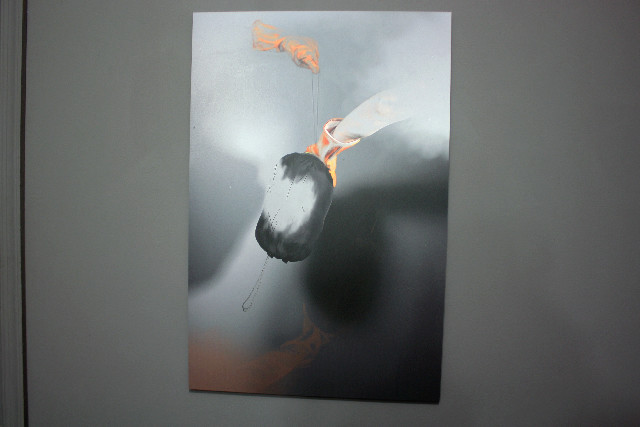
Michael Bussell, “Title Sequence” UV print on dibond. I was at first drawn to this because I couldn’t tell what the medium is. At different moments it reads like a painting, photograph, CGI, or drawing.
Down the block, Springsteen‘s impossibly crisp space got a dingy makeover for the two-person show Machine in the Garden. This installation from Bea Fremderman comprises old clothes left in garbage bags with chia seeds. The result is a room full of dress shirts, panties, and bras with roots growing between the fibers and dead sprouts covered in a layer of mold. It smells terrible and looks amazing, especially in dialogue with Andrew Laumann’s scraped paintings. I was told Fremderman conceived of the piece as a totally non-commodifiable practice. (On view until April 23rd)
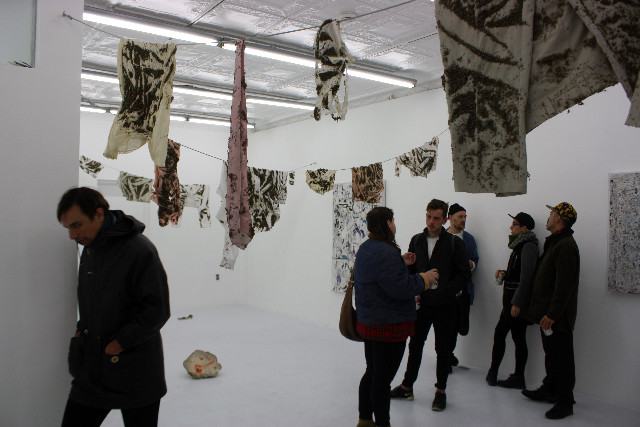
At Springsteen, an installation by Bea Fremderman and paintings by Andrew Laumann.
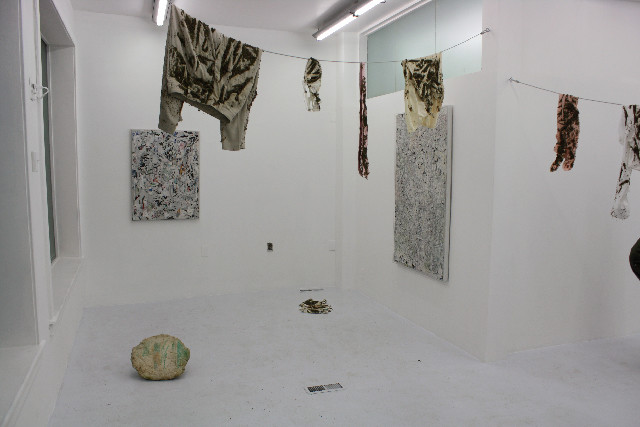
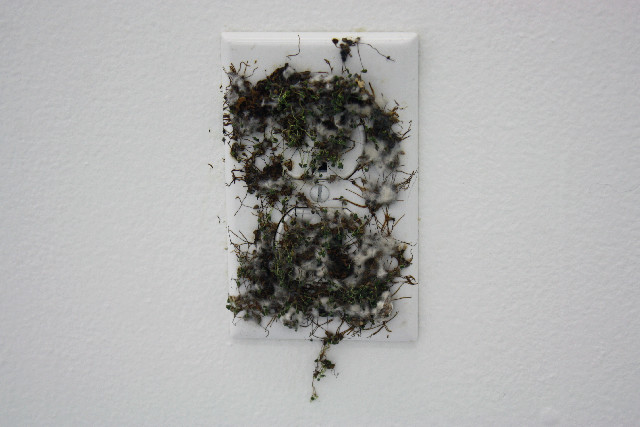
There’s something so satisfying about a disgustingly moldy outlet faceplate in an otherwise flawless white cube.
Next door, First Continent blocked out its windows with mylar for the group show Mutiny in Heaven, curated by Valerie Keane. The gallery was so much darker than the streetlights outside it felt like walking in to a haunted house, a vibe perfectly suited to the work.
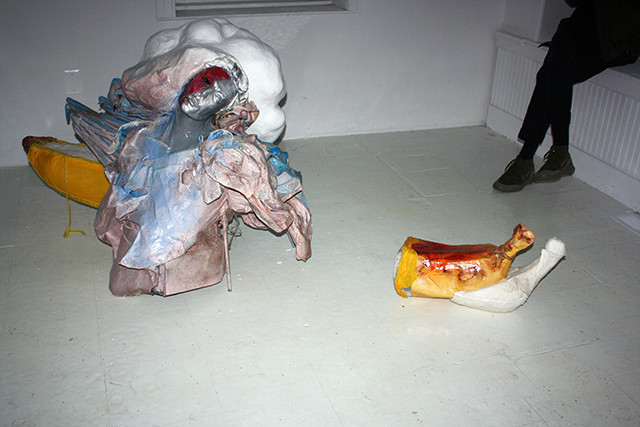
Danica Barboza, “Kitsch, for Our Love-Child’s Bedroom”
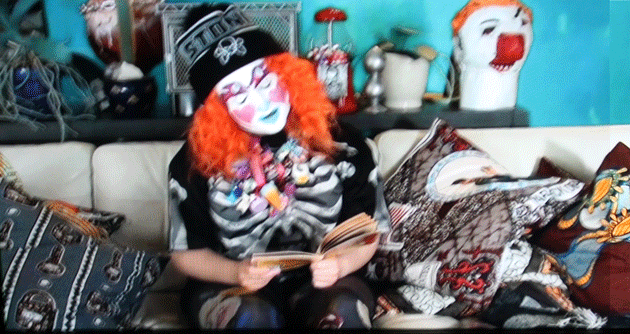
GIF of Bailey Scieszka’s video piece “Masterbeast Theatre.”

Jessie Stead, “Rubin’s Pirated Phone Book.” Each of these desktop icons has been renamed to create a poem. [Click for full-size image]
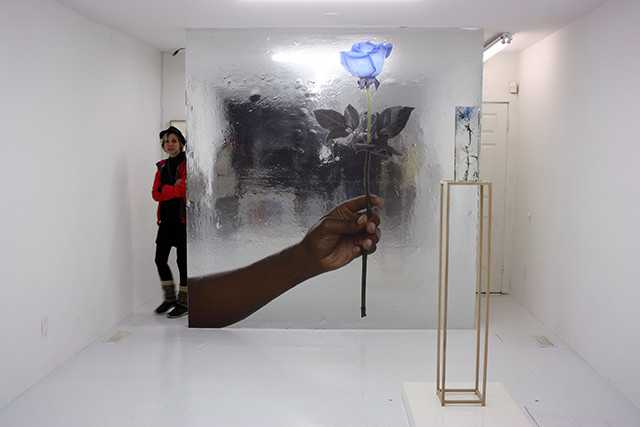

Virginia Poundstone
Current Gallery opened two exhibitions Saturday night. In the main gallery, the group show Surface Tension, curated by Joseph Shaikewitz, featured more works by Taha Heydari alongside other painters who address the screen or a sense of permeability in their work. Usually, I find it distracting when shows are this visually crowded. Here, it barely detracted from the individual pieces—and the dialogue established between paintings made me appreciate them all more. (On view until May 1st)

Taha Heydari (L) with Colin Alexander (R). This pairing is one of my favorites. Heydari’s painting reminds me of those terrible pirated DVDs one buys on the subway where you end up watching a movie with Russian subtitles through the view of someone’s camcorder. They make so much sense with Alexander’s incomplete movie logos.
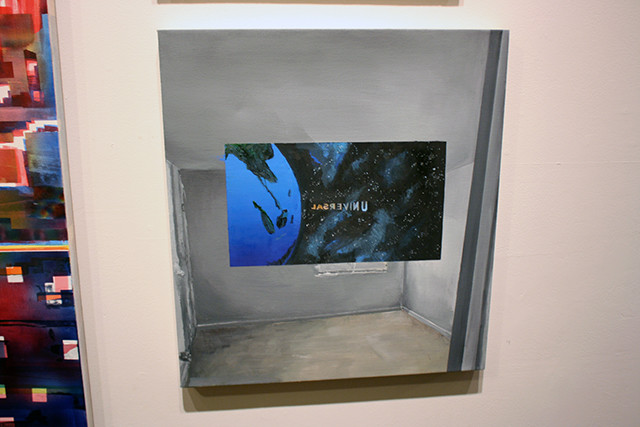
Colin Alexander’s calculated balance of meticulous and naive paint handling seems loaded with anxiety, punctuated by moments of abandon. They feel stressful and cathartic—it’s refreshing to see figurative painting that’s smart but doesn’t mask the artist’s hand in layers of irony.
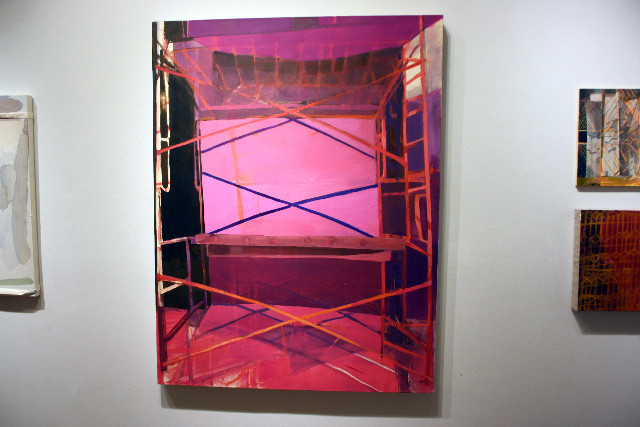
Marisa LaGuardia
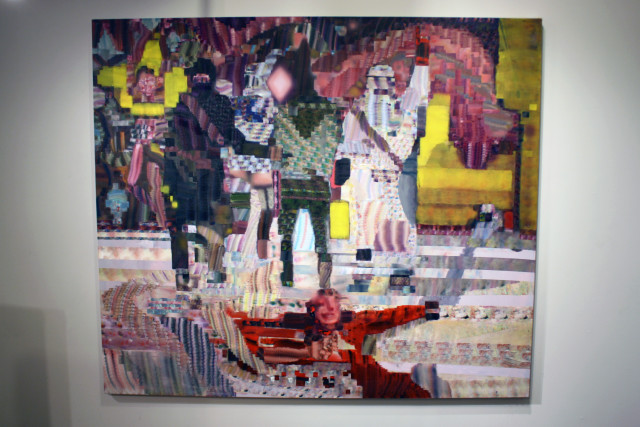
Taha Heydari. I can’t tell if this is a garbled still from a low-res ISIS video or a scene from a “Star Wars” bootleg. Either way, it’s a little creepy and seductive—like one of those Google “deep dream” images.
In the project space, Russell Hite’s Sun Dogs was probably one of the most crowd-pleasing openings I’ve been to in a long time. It’s impossible to not cheer up looking at these drawings, which feel like stream-of-conscious doodles realized as complete, but casual illustrations. They’re populated by cartoonish fruits and vegetables, skunks in high heels, and superheroes—all smiling. The figures are almost all floating in blank negative space, but they make me think of the beach. These are like greeting cards for holidays I wish existed. (On view until May 1st)
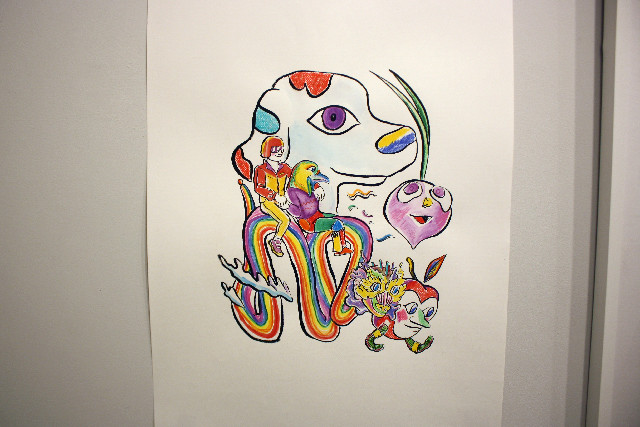
Russell Hite

Russell Hite
And at Open Space, the PMF organizers smartly opted for an understated show to coincide with the fair: The Midnight Room, from illustrator Aidan Koch. Koch’s sequential images distill comics down to their barest suggestion of narrative. Every panel is visually sparse but packs a variety of mark-making and textures. They feel introverted and serious without being nerdy—the perfect foil to a weekend of partying indie comic enthusiasts.
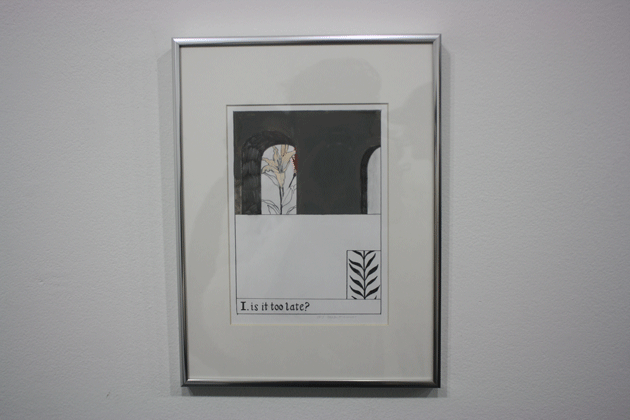
Aidan Koch


Comments on this entry are closed.